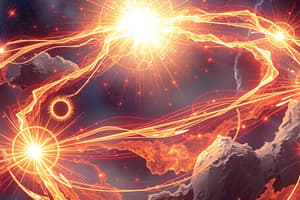Podcast
Questions and Answers
Which fundamental force is responsible for holding protons and neutrons together in atomic nuclei?
Which fundamental force is responsible for holding protons and neutrons together in atomic nuclei?
- Weak Nuclear Force
- Gravitational Force
- Electromagnetic Force
- Strong Nuclear Force (correct)
According to Newton's Second Law of Motion, how is force related to mass and acceleration?
According to Newton's Second Law of Motion, how is force related to mass and acceleration?
- Force equals acceleration divided by mass
- Force equals mass divided by acceleration
- Force equals mass plus acceleration
- Force equals mass times acceleration (correct)
What is the formula for calculating kinetic energy?
What is the formula for calculating kinetic energy?
- KE = mv
- KE = 1/2 mv² (correct)
- KE = Fd
- KE = mgh
Which law states that the entropy of an isolated system always increases?
Which law states that the entropy of an isolated system always increases?
What does Ohm's Law describe in electrical circuits?
What does Ohm's Law describe in electrical circuits?
In the context of quantum mechanics, what does the Uncertainty Principle imply?
In the context of quantum mechanics, what does the Uncertainty Principle imply?
What is the relationship between wave speed, frequency, and wavelength?
What is the relationship between wave speed, frequency, and wavelength?
What defines gravitational potential energy in relation to mass and height?
What defines gravitational potential energy in relation to mass and height?
How does special relativity alter our understanding of time?
How does special relativity alter our understanding of time?
What is one characteristic of wave-particle duality in quantum mechanics?
What is one characteristic of wave-particle duality in quantum mechanics?
Flashcards are hidden until you start studying
Study Notes
Key Concepts in Physics
-
Fundamental Forces
- Gravitational Force: Attraction between masses.
- Electromagnetic Force: Interaction between charged particles.
- Strong Nuclear Force: Holds protons and neutrons together in atomic nuclei.
- Weak Nuclear Force: Responsible for radioactive decay.
-
Newton's Laws of Motion
- First Law (Inertia): An object at rest stays at rest, and an object in motion stays in motion unless acted upon by a net force.
- Second Law (F=ma): Force equals mass times acceleration; describes how the velocity of an object changes when it is subjected to an external force.
- Third Law (Action-Reaction): For every action, there is an equal and opposite reaction.
-
Energy
- Kinetic Energy: Energy of motion (KE = 1/2 mv²).
- Potential Energy: Stored energy due to position (PE = mgh for gravitational potential energy).
- Conservation of Energy: Energy cannot be created or destroyed, only transformed.
-
Thermodynamics
- First Law: Energy conservation in thermodynamic processes.
- Second Law: Entropy of an isolated system always increases; heat cannot spontaneously flow from cold to hot.
- Third Law: As temperature approaches absolute zero, the entropy of a perfect crystal approaches zero.
-
Wave Properties
- Frequency: Number of waves that pass a point per second (measured in Hertz).
- Wavelength: Distance between successive crests of a wave.
- Amplitude: Height of the wave, relates to the energy carried by the wave.
- Wave Speed: v = fλ (speed = frequency × wavelength).
-
Electricity and Magnetism
- Ohm's Law: V = IR (voltage = current × resistance).
- Electric Field: A field around charged particles that exerts force on other charges.
- Magnetic Field: Created by moving electric charges and magnets; influences other charges and magnets.
-
Relativity
- Special Relativity: Time and space are relative; time dilation and length contraction occur at high speeds.
- General Relativity: Gravity is a curvature of spacetime caused by mass.
-
Quantum Mechanics
- Wave-Particle Duality: Particles can exhibit properties of both waves and particles.
- Uncertainty Principle: It’s impossible to simultaneously know both the position and momentum of a particle with absolute certainty.
- Quantum States: Describes the probabilistic behavior of particles.
-
Important Units
- SI Units: Standard units for measurements (e.g. meter for distance, kilogram for mass, second for time).
- Energy: Joule (J), Power: Watt (W), Force: Newton (N).
-
Applications of Physics
- Engineering: Principles applied to design structures and systems.
- Medicine: Imaging technologies (e.g., X-rays, MRIs) rely on physics principles.
- Environmental Science: Understanding natural processes (e.g., climate change requires knowledge of thermodynamics).
These concise notes highlight essential topics and principles that form the foundation of physics, aiding in a fundamental understanding of the subject.
Fundamental Forces
- Gravitational Force: Attraction between any two objects with mass.
- Electromagnetic Force: Interaction between charged particles (electric and magnetic fields).
- Strong Nuclear Force: Binds protons and neutrons together in the nucleus of an atom, overcoming electrostatic repulsion, very short range.
- Weak Nuclear Force: Causes radioactive decay (beta decay) by changing a neutron into a proton, important for nuclear fusion in the Sun.
Newton's Laws of Motion
- First Law (Inertia): An object at rest stays at rest, and an object in motion stays in motion with the same speed and direction unless acted upon by an unbalanced force.
- Second Law (F=ma): Force equals mass times acceleration; describes how the velocity of an object changes when it is subjected to an external force.
- Third Law (Action-Reaction): For every action (force), there is an equal and opposite reaction.
Energy
- Kinetic Energy: Energy of motion (KE = 1/2 mv², where m is mass, v is velocity).
- Potential Energy: Stored energy due to an object's position or state (PE = mgh for gravitational potential energy, where m is mass, g is acceleration due to gravity, h is height).
- Conservation of Energy: Energy cannot be created or destroyed, only transformed from one form to another (e.g., potential energy converts to kinetic energy as a ball falls).
Thermodynamics
- First Law: Energy is conserved in thermodynamic processes (energy can neither be created nor destroyed, only transferred or transformed).
- Second Law: Entropy (a measure of disorder) of an isolated system always increases over time; heat cannot spontaneously flow from a cold object to a hotter object without external work.
- Third Law: As temperature approaches absolute zero (0 Kelvin), entropy of a perfect crystal approaches zero (the lowest possible energy state).
Wave Properties
- Frequency: Number of waves that pass a point per second (measured in Hertz, Hz).
- Wavelength: Distance between successive crests of a wave.
- Amplitude: The height of a wave, related to the energy carried by the wave.
- Wave Speed: v = fλ (speed = frequency × wavelength).
Electricity and Magnetism
- Ohm's Law: V = IR (voltage = current × resistance).
- Electric Field: A field around charged particles that exerts force on other charges.
- Magnetic Field: Created by moving electric charges and magnets; influences other charges and magnets.
Relativity
- Special Relativity: Time and space are relative:
- Time Dilation: Time slows down for objects moving at speeds close to the speed of light.
- Length Contraction: Objects appear shorter in the direction of motion when traveling at speeds close to the speed of light.
- General Relativity: Gravity is a curvature of spacetime caused by mass; the more mass, the more curvature.
Quantum Mechanics
- Wave-Particle Duality: Particles (e.g., light, electrons) can exhibit properties of both waves and particles.
- Uncertainty Principle: It’s impossible to simultaneously know both the position and momentum of a particle with absolute certainty.
- Quantum States: Describes the probabilistic behavior of particles (e.g., the likelihood of finding an electron at a particular location).
Important Units
- SI Units: Standard units for measurements: meter (m) - distance, kilogram (kg) - mass, second (s) - time.
- Energy: Joule (J), Power: Watt (W), Force: Newton (N).
Applications of Physics
- Engineering: Applications of physics principles in the design and construction of different structures and systems (e.g., bridges, buildings, airplanes).
- Medicine: Medical diagnostic and therapeutic tools are based on physics principles (e.g., X-rays, MRIs, lasers, ultrasound).
- Environmental Science: Understanding natural processes (e.g., climate change) and developing solutions requires a deep understanding of physical principles.
Studying That Suits You
Use AI to generate personalized quizzes and flashcards to suit your learning preferences.




